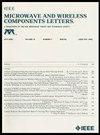用于5G通信的65纳米CMOS 39 ghz反相变增益功率放大器
IF 3.3
2区 工程技术
Q2 ENGINEERING, ELECTRICAL & ELECTRONIC
引用次数: 1
摘要
这封信介绍了一种用于5G通信的39 ghz逆变变增益功率放大器(VGPA)。VGPA采用基于Gilbert结构的可变增益放大器(VGA)级,实现了db线性增益控制特性和180°相位反转。在0°/180°相位状态下,39 ghz VGPA的最大增益分别为38.7/38.9 dB,增益调谐范围为5.6/5.2 dB。在38 ~ 43 GHz范围内,相位反转误差控制在5.9°以内,均方根相位误差小于3.6°/2.2°。同时,在金属交错共面变压器匹配网络下,该VGPA在饱和和1db压缩点分别达到17.7/17.6 dbm Psat和13.2/13.36 dbm OP1 dB,功率附加效率(PAE)分别为35%/34.5%和13.6%/14.4%。在增益控制状态下,OP1 dB波动小于0.3 dB。该VGPA采用65纳米CMOS工艺,功耗为150mw,芯片面积为0.3 mm2。本文章由计算机程序翻译,如有差异,请以英文原文为准。
A 39-GHz Phase-Inverting Variable Gain Power Amplifier in 65-nm CMOS for 5G Communication
This letter presents a 39-GHz phase-inverting variable gain power amplifier (VGPA) for 5G communication. Adopting a Gilbert structure-based variable gain amplifier (VGA) stage, the VGPA realized the dB-linear gain control characteristic as well as 180° phase inversion. At 0°/180° phase states, the 39-GHz VGPA achieves the maximum gain of 38.7/38.9 dB with gain tuning range of 5.6/5.2 dB, respectively. Over 38–43 GHz, the phase inversion error is limited within 5.9°, and the rms phase error is less than 3.6°/2.2°. Meanwhile, with the metal interleaving coplanar transformer matching network, this VGPA achieves 17.7/17.6-dBm Psat and 13.2/13.36-dBm OP1 dB, with the power added efficiency (PAE) of 35%/34.5% and 13.6%/14.4% at the saturation and 1-dB compression points, respectively. Over the gain control states, the OP1 dB fluctuation is less than 0.3 dB. Implemented in a 65-nm CMOS process, the proposed VGPA consumes 150 mW with a chip area of 0.3 mm2.
求助全文
通过发布文献求助,成功后即可免费获取论文全文。
去求助
来源期刊

IEEE Microwave and Wireless Components Letters
工程技术-工程:电子与电气
自引率
13.30%
发文量
376
审稿时长
3.0 months
期刊介绍:
The IEEE Microwave and Wireless Components Letters (MWCL) publishes four-page papers (3 pages of text + up to 1 page of references) that focus on microwave theory, techniques and applications as they relate to components, devices, circuits, biological effects, and systems involving the generation, modulation, demodulation, control, transmission, and detection of microwave signals. This includes scientific, technical, medical and industrial activities. Microwave theory and techniques relates to electromagnetic waves in the frequency range of a few MHz and a THz; other spectral regions and wave types are included within the scope of the MWCL whenever basic microwave theory and techniques can yield useful results. Generally, this occurs in the theory of wave propagation in structures with dimensions comparable to a wavelength, and in the related techniques for analysis and design.
 求助内容:
求助内容: 应助结果提醒方式:
应助结果提醒方式:


